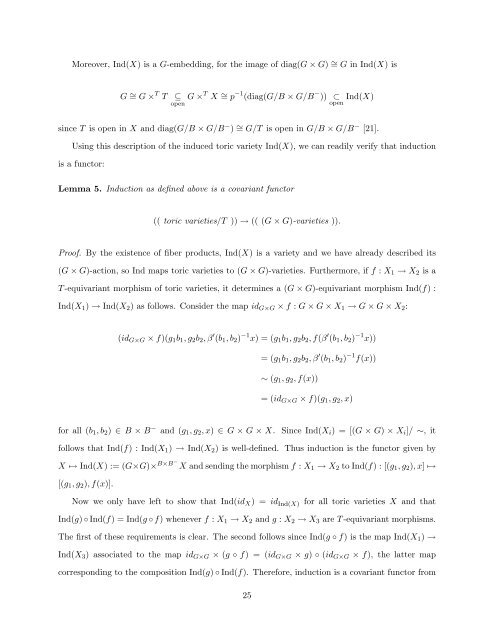Equivariant Embeddings of Algebraic Groups
Equivariant Embeddings of Algebraic Groups
Equivariant Embeddings of Algebraic Groups
Create successful ePaper yourself
Turn your PDF publications into a flip-book with our unique Google optimized e-Paper software.
Moreover, Ind(X) is a G-embedding, for the image <strong>of</strong> diag(G × G) ∼ = G in Ind(X) is<br />
G ∼ = G × T T<br />
⊆ G × T X ∼ = p −1 (diag(G/B × G/B − )) ⊂ Ind(X)<br />
open<br />
open<br />
since T is open in X and diag(G/B × G/B − ) ∼ = G/T is open in G/B × G/B − [21].<br />
Using this description <strong>of</strong> the induced toric variety Ind(X), we can readily verify that induction<br />
is a functor:<br />
Lemma 5. Induction as defined above is a covariant functor<br />
(( toric varieties/T )) → (( (G × G)-varieties )).<br />
Pro<strong>of</strong>. By the existence <strong>of</strong> fiber products, Ind(X) is a variety and we have already described its<br />
(G × G)-action, so Ind maps toric varieties to (G × G)-varieties. Furthermore, if f : X 1 → X 2 is a<br />
T -equivariant morphism <strong>of</strong> toric varieties, it determines a (G × G)-equivariant morphism Ind(f) :<br />
Ind(X 1 ) → Ind(X 2 ) as follows. Consider the map id G×G × f : G × G × X 1 → G × G × X 2 :<br />
(id G×G × f)(g 1 b 1 , g 2 b 2 , β ′ (b 1 , b 2 ) −1 x) = (g 1 b 1 , g 2 b 2 , f(β ′ (b 1 , b 2 ) −1 x))<br />
= (g 1 b 1 , g 2 b 2 , β ′ (b 1 , b 2 ) −1 f(x))<br />
∼ (g 1 , g 2 , f(x))<br />
= (id G×G × f)(g 1 , g 2 , x)<br />
for all (b 1 , b 2 ) ∈ B × B − and (g 1 , g 2 , x) ∈ G × G × X. Since Ind(X i ) = [(G × G) × X i ]/ ∼, it<br />
follows that Ind(f) : Ind(X 1 ) → Ind(X 2 ) is well-defined. Thus induction is the functor given by<br />
X ↦→ Ind(X) := (G×G)× B×B− X and sending the morphism f : X 1 → X 2 to Ind(f) : [(g 1 , g 2 ), x] ↦→<br />
[(g 1 , g 2 ), f(x)].<br />
Now we only have left to show that Ind(id X ) = id Ind(X) for all toric varieties X and that<br />
Ind(g) ◦ Ind(f) = Ind(g ◦ f) whenever f : X 1 → X 2 and g : X 2 → X 3 are T -equivariant morphisms.<br />
The first <strong>of</strong> these requirements is clear. The second follows since Ind(g ◦ f) is the map Ind(X 1 ) →<br />
Ind(X 3 ) associated to the map id G×G × (g ◦ f) = (id G×G × g) ◦ (id G×G × f), the latter map<br />
corresponding to the composition Ind(g) ◦ Ind(f). Therefore, induction is a covariant functor from<br />
25
















